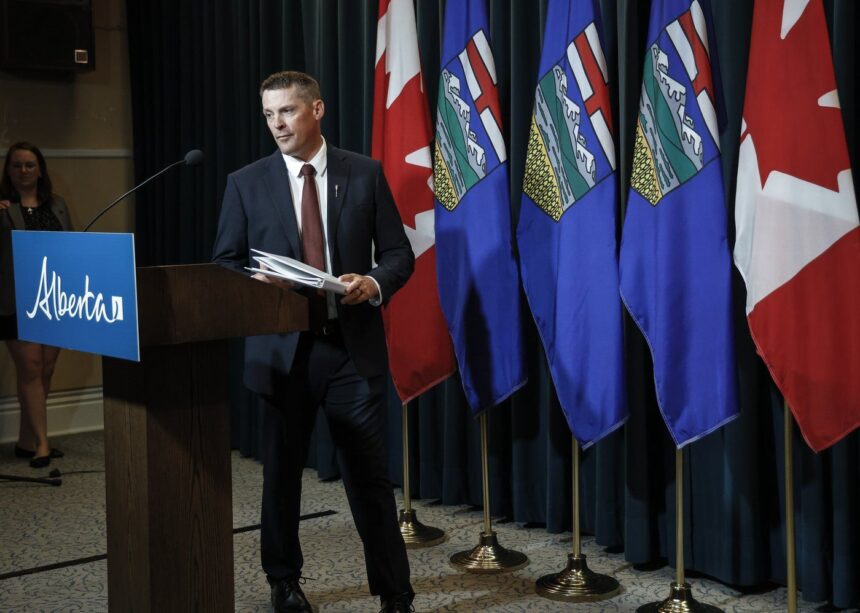The Alberta government plans to announce a $5.8 billion surplus in its upcoming fiscal update, according to sources close to the finance ministry. This marks the third consecutive year of budget surpluses for Canada’s energy powerhouse province, but economic analysts remain divided on whether this prosperity represents sustainable economic strength or temporary good fortune.
Finance Minister Travis Toews is expected to deliver the year-end fiscal update next week, highlighting how resource revenues have consistently outperformed projections. The government credits its fiscal discipline and economic policies for the positive results, pointing to Alberta’s growing population and diversification efforts beyond traditional oil and gas.
“The numbers tell a compelling story about Alberta’s economic resilience,” said Martha Davidson, chief economist at Western Canada Economic Institute. “But we need to look beyond the headline figures to understand what’s happening beneath the surface.”
The projected surplus represents approximately 8.3% of Alberta’s annual provincial budget – a remarkable achievement given the volatility in global energy markets over the past year. Oil prices have maintained an average of $77 per barrel throughout the fiscal year, well above the conservative $70 forecast used in budget planning.
However, economic observers note that roughly 65% of the surplus stems directly from elevated resource revenues, raising familiar questions about Alberta’s dependence on the energy sector. The province’s attempts to diversify its economic base have shown promising signs but remain proportionally small compared to traditional energy income.
Lyle Montgomerie, former advisor to the Alberta Treasury Board, told me that while the surplus represents good fiscal management, it also highlights Alberta’s continued vulnerability. “The province rides this revenue roller coaster every decade. What matters is how we use these funds during the good times to prepare for inevitable downturns.”
The provincial government has signaled that approximately $2.1 billion of the surplus will go toward debt reduction, continuing Alberta’s aggressive strategy to minimize its debt-to-GDP ratio, already the lowest among Canadian provinces at 10.3%. Another $1.7 billion is earmarked for the Heritage Savings Trust Fund, Alberta’s long-term investment vehicle.
This leaves approximately $2 billion that remains unallocated, creating political tension about spending priorities. Opposition parties have called for increased healthcare funding, particularly in rural communities where staffing shortages persist despite Alberta’s overall economic health.
“We’re seeing a two-speed recovery,” noted Dr. Sarah Weinstein, healthcare policy researcher at the University of Calgary. “Urban centers are thriving with new investment and development, while many rural communities still struggle with basic service delivery despite the provincial coffers overflowing.”
The surplus announcement comes as Alberta’s tech sector shows remarkable growth, with Calgary now hosting over 3,000 tech companies – a 27% increase since 2022. The province’s efforts to position itself as Canada’s “innovation corridor” appear to be gaining traction, with venture capital investment reaching $1.3 billion last year.
Dan Williams, founder of Calgary-based energy tech startup GridSmart, sees a changing landscape. “Five years ago, I would have needed to relocate to Toronto or Vancouver to find funding. Today, we’ve raised $17 million without leaving Alberta. The ecosystem has matured tremendously.”
Yet challenges remain. Alberta’s economy still generates approximately 38% more greenhouse gas emissions per capita than the Canadian average, creating regulatory and market access complications as global investors increasingly prioritize environmental metrics.
The fiscal update is also expected to address inflation concerns, with Alberta’s consumer price index running at 3.1% – slightly above the national average. Housing affordability has emerged as a particular pressure point, with median home prices in Calgary increasing 12.7% year-over-year.
For everyday Albertans like Edmonton teacher Maria Gonzalez, the surplus announcements generate mixed feelings. “It’s great that we’re not running deficits, but my classroom still has 32 students, and I’m buying supplies out of pocket,” she told me. “Sometimes these big numbers feel disconnected from our daily reality.”
Premier Danielle Smith has hinted at potential tax relief measures to be announced with the fiscal update, potentially including an expanded provincial carbon tax rebate program and adjustments to small business tax rates.
Meanwhile, economists point to concerning signals in global markets that could impact Alberta’s fiscal outlook. Chinese economic growth has slowed to 4.5%, potentially reducing demand for energy exports, while the transition toward renewable energy continues to accelerate globally.
“This surplus should be viewed through the lens of long-term planning, not short-term politics,” said Montgomerie. “Alberta has a once-in-a-generation opportunity to build genuine economic resilience, but only if these funds are invested strategically rather than spent tactically.”
As the finance minister prepares to deliver next week’s update, Albertans will be watching closely to see whether this period of prosperity becomes a foundation for sustainable growth or merely another chapter in the boom-and-bust cycle that has defined the province’s economic history.






